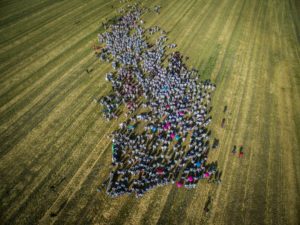Below is an edited version of a piece originally published on Noteworthy. Read the original here.
A short while ago, a fellow former digital director posted this on Facebook:
“Just for funsies: Do you think digital should report to comms? to field? digital people inside of comms and field but not in a digital department? Have you ever put these ideas into practice? What worked and what didn’t?”
The comments exploded — as did the minds of many people who grapple with this same question every day. Opinions ranged from “digital should report to comms”, “digital should report to field”, “everything should report to digital”, and “there should be no such thing as digital”. It was clear that, in a constantly shifting technological and political landscape, we have not reached anything like consensus around best practice.
Every organisation and campaign is different, with its own needs, but I’m here to make the case that “digital” is no longer a useful distinction. You should consider dismantling your digital department entirely, if you have one.
Three reasons to do away with digital departments
1) “Digital” is not a skill set — just as paper isn’t a skill set. There’s a huge difference in the abilities required for writing fiction, non-fiction, or long romantic love letters. So it is with digital.
I went into 350.org on the assumption that I would be building up a rapid response petition platform and online fundraising programme. But pretty soon into my tenure, it was clear that what the organisation needs right now is better distribution strategies for our content, tools that can successfully fulfil the needs of our organisers and campaigners, tons of trainings for our on-the-ground staff and volunteers — and an enormous amount of work cleaning up our data, syncing it up, and making it accessible and interpretable by those who need it.
All of these things are related to “digital”, but require an incredibly broad spectrum of skills and strategies to address. If you lump them all together in one department, you risk conflating many complex problems, and expecting overburdened and misunderstood staff to solve them for you.
2) There is no such thing as “offline” anymore. Even if an organiser’s daily work is 90% out of the office and in the community, they need to be adept at using digital tools. An organiser needs to be able to enter people’s contact details into a CRM app or similar; follow up over email, text, or social media; track interactions; and promote and broadcast events. The work of building personal relationshipscan’t be outsourced.
3) You would not have a digital department if you founded an organisation now. A tech director or chief technology officer might be one of your first hires to ensure that critical decisions around technical infrastructure and supporter data storage are being made at leadership level — but it’s less likely that you would build a digital department. A recent NetChange report, Digital Engagement Teams in 2018, reflected this trend, revealing that only 13% of the organisations surveyed across the US, Canada, Australia and UK ran a standalone digital department.
Building a product team and distributing responsibility
So what would you do instead? Hopefully, you would hire digitally skilled staff to populate every department, and you would invest, maintain, and consistently upgrade the tools that they use.
We can all dream.
Since those of us in established organisations can’t (and wouldn’t want to) start from scratch, the strategy we’re taking at 350.org is more circuitous. Here’s what we’re up to:
1) Building a product team, who will be responsible for developing and implementing the roadmaps for our data, CRM, web products, and organising and campaigns tools. To do that, we’re growing our tech capacity from one full-time developer and one part-time developer in 2017 to a team of 15 tech specialists in 2019. Yes, mate! We’re serious.
Product teams are now prevalent in for-profit organisations, and gaining traction within the non-profit sector too (my old employer SumOfUs has had a product team for years). A metaphor we’ve been using internally is that the product team = Q from the James Bond franchise, the head of the fictional research and development division of the British Secret Service, and the maker of fancy gadgets like bagpipe flamethrowers and killer umbrellas…
2) Distributing other digital functions across teams. If the product team is Q, then our secret agents are those staff who are experts in social media, multimedia, and digital organising and campaigns strategies. These staff are not-so-stealthily moving into the communications and programme departments, and their mission is to integrate digital strategy into our overall strategies from the get-go, to train those who have previously been “offline” only, and to be the product team’s points of contact — letting us know what they need and how we can serve them best.
When it comes to using the tools to meet our mission — that responsibility is everyone’s, and should be shared. By sharing that responsibility, along with a much higher level of access to our tools and data across the board, our hope is that we can make better decisions, and faster.
As tech evolves, so must organisations
Where are we at now?
We’ve not completed this process, but we’ve already seen wins by being able to shift our focus, invest many more resources, and put tech specialists in place. We’re merging our various email lists and we now have data syncs established between our many systems (people are hopefully receiving the communications they signed up for! Very important!). We’re building dashboards so that campaigners and organisers have easy access to real-time data. Soon, we will also be spinning up a training and coaching programme for our staff in how to use our tools with ease and speed.
It’s not the last time our structure will change. As time passes, tech evolves, and the way we organise changes, we’ll have to make more shifts. But some wisdom I’ve heard this year is that when your structure has caught up to your mission, your organisation has started to stagnate.
If the above hasn’t convinced you — here’s my final card. One result of us dismantling the digital department is that the operations department will be hiring IT support! Embrace the future — never make an email address or fix someone’s Zoom issue again just because you have “digital” in your title.
Huge thanks to The Build Tank who we’ve been working with to establish 350.org’s new product team (and who wrote their own article about this during our first conversations earlier this year).
Thanks also to Taren Stinebrickner-Kauffman, Katy Cashman and Hoda Baraka who contributed to a first draft of this post.
Photo credit: Around 300 young people in Jakarta joined the #riseforclimate in September 2018 to demand a just and rapid transition to 100% renewable energy. Photo by 350.org. CC BY-NC-SA 2.0




